The defeat of Mother Brain doesn’t mean it’s game over, of course. It wouldn’t be Metroid if you didn’t have to run desperately to the exit before the enemy base explodes.
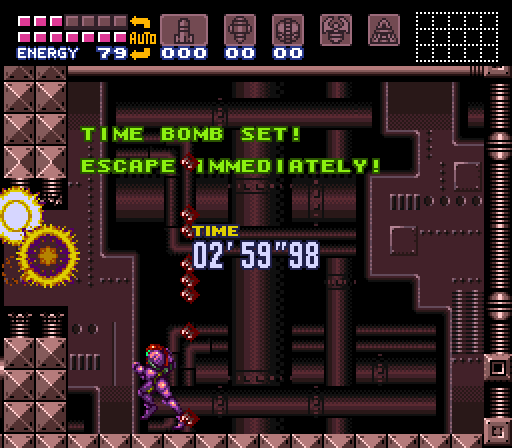
You have three minutes to reach your gunship before Mother Brain’s lair detonates. While the notion of an escape sequence should feel like old hat for Metroid fans, the Super Metroid take on the concept differs somewhat from that of the first two games. The original Metroid‘s escape sequence was a tense reprise of that early sequence in which players climbed a seemingly endless shaft made far more difficult by the tiny size of the platforms and Samus’ slippery jump physics. Metroid II‘s escape scene was the exact opposite: A stress-free climb back to the beginning of the game made possible by the baby metroid.
Super Metroid, on the other hand, takes a third tack. Although the platforming here isn’t nearly as difficult as in the first game, the exit route is much more convoluted. The challenge isn’t simply jumping with swift precision but rather finding the proper path.
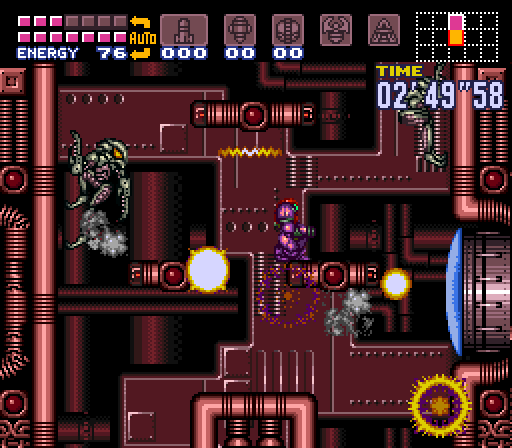
It doesn’t help that the place is lousy with space pirates. Sure, the Hyper Beam cuts through them with surgical precision, but their acrobatics and energy blasts can slow you down, especially if you’re trying to take the sustained space jump approach to the end.
The escape sequence consists of two main rooms. The first is a sort of mini-maze that can easily trick you into wasting time by following the wrong path – though it does offer a direct route that you can streak through by using the Speed Booster to rush to the end and air-dash through a portion of floor if you know it’s there. The second is more linear, but it’s convoluted in its linearity, forcing you to double back several times.
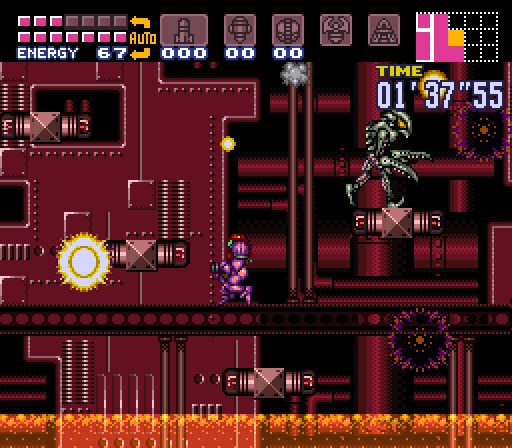
At the end, you have to deal with a room reminiscent of the large cavern following the acquisition of the Screw Attack: Lava rises, scattered platforms occupied by space pirates prevent you from simply jumping to freedom, and a ledge beneath the exit boxes you in if you stick to the right side of room. Where you could afford to screw up in Norfair and still come out ahead, too much of a goof here will cost precious time and prevent you from escaping properly.

And just to rub salt in the wound, the escape route actually ends up leading you back to the ruins of the exit shaft from the first game. Granted, you have a Space Jump now, so it’s nowhere near as hard as in the original Metroid, but it definitely gives you an “oh crap” sensation once you dash through what appears to be the exit only to find this waiting for you. Oh, and the acid or lava or whatever rises here well. No rest for the weary.
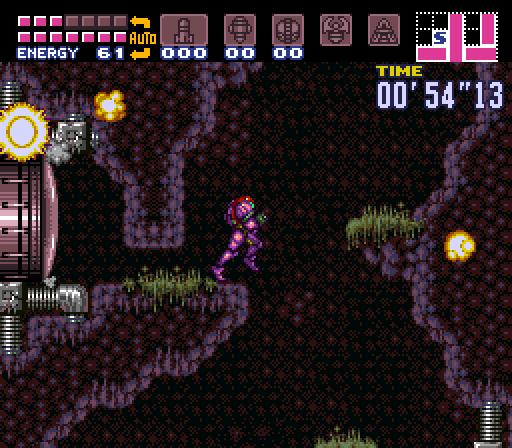
Eventually, you’ll end up back in the “real” game world again, covering ground that you saw very early in the game (and possibly passed through in a hurry once or twice since then). While being thrust into the non-linear corridors Zebes could become disorienting or confusing while you’re rushing to freedom, the designers very helpfully locked down all non-essential doors. There’s no way to get lost here, because you’re being guided. As so often has been the case with Super Metroid, arbitrary door locks keep you from wandering or backtracking at inopportune times. The fact that no one ever complains about this in Super Metroid but rail against it in Metroid Fusion will make for a handy object lesson in subtlety of design, I think.

Well, there is one non-essential door you can duck through if you like; go down one screen to the right once you reach the surface of Crateria and you’ll find the room that used to lead to the first Torizo and Samus’ Bomb power-up now features your little tutorial friends locked in a cage for some reason. How they got here is a mystery – maybe Mother Brain was ticked that they helped you out? – but the fact that they’ve been corralled here works to their benefit. Once you free them, you can head out on your way again.
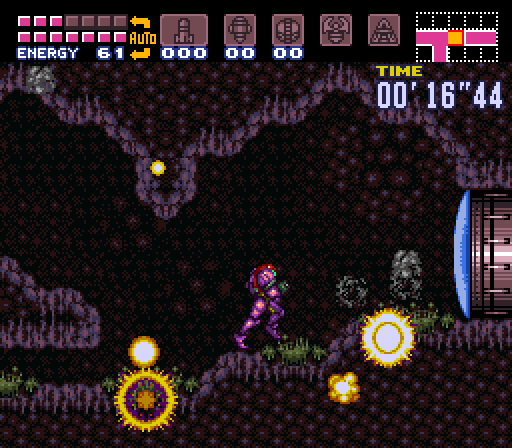
The explosions surrounding Samus grow more violent as the clock ticks down. This is kind of like Call of Duty and Uncharted, huh?
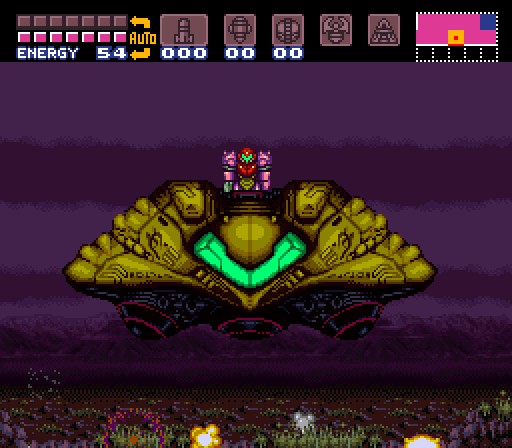
Your ultimate goal, of course, is Samus’ ship. Once you reach it, the game is truly over: Samus automatically drops down into the cockpit and returns to space.
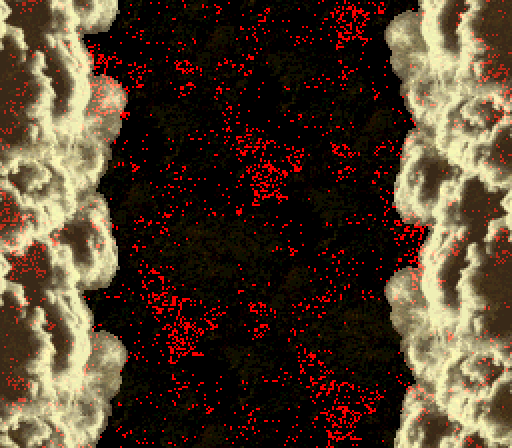
Up through the fancy Mode 7 clouds, where the entire surface of the planet appears dappled with fiery light.

And this time around, it’s not just the space pirate base that explodes; somehow the whole of Zebes goes up in flames.
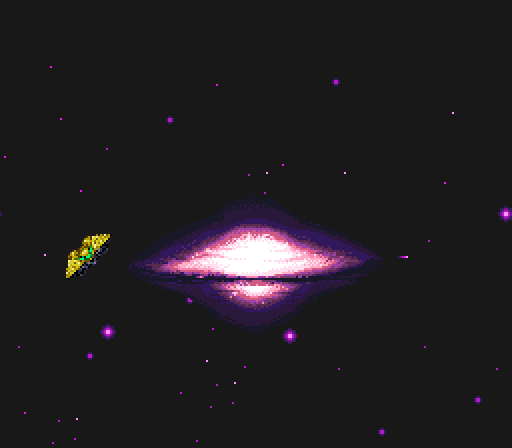
Farewell, Zebes. Farewell, tormented souls of the Wrecked Ship. Farewell, mournful Draygon babies. Farewell, overly protective mother turtle and your innocent children. Farewell, dead adventurer guy and the grody space-bugs who were munching on him. Everything is gone now.
Only your tutorial buddies escape, should you set them free, flying away from the cataclysm as a tiny dot to parts unknown.
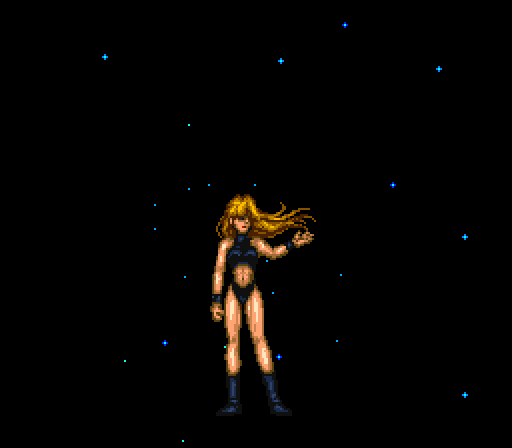
In the end, you’re given the obligatory time-based variable ending. Complete the game quickly enough and, per usual, Samus strips down to a bikini. Hey, just because she’s the most powerful woman in the galaxy, capable of single-handedly putting a stop to an entire race and blowing up a whole damn planet doesn’t mean she gets to have dignity. Come on, this is video games, man.
Look at those abs, though. She and Vaan should do fitness video together or something.

Interestingly, Super Metroid doesn’t tell you how long you took to complete the game as Metroid II did. Instead, it tracks the percentage of items you’ve collected. This distinction made a huge impact on how fans would come to treat the game in the following years, helping to inspire them to approach their playthroughs in different ways. Fastest possible complete runs were the obvious outcome; less obvious were self-imposed challenges to see just how few items are needed to complete the game.
Of course, the real secret behind Super Metroid‘s extensive playability is its excellence. The game is fantastic, exquisitely designed from start to finish with hardly a misstep to be found. Those play variants are ultimately just excuses for people to explore a masterpiece in new ways, like watching a beloved film with director’s commentary on. Super Metroid endures through the ages simply because it’s great.
Though of course there are a few other reasons, too.
You were right in a previous entry that part of this game’s appeal comes from familiarity with the first game. I personally loved that this game reused the original escape shaft multiple ways, concluding with having the player reuse it for its original purpose. It’s also possible during the escape sequence to shinespark up through the right side of the shaft. The only hint that this is possible is the fact that the game gives you enough runway to get up to speed by the time you get up to that point in the room. The X-ray scope won’t reveal the weakness of the platforms above.
Really? Where do you jump for that to work? I’m pretty sure I’ve been stopped by the ledges lining the walls.
All the way on the right, and you’re golden.
It does show your clear time, just not at the very end. It’s displayed just before the credits roll.
Great analysis!
Oops, you’re right.
“The fact that no one ever complains about this in Super Metroid but rail against it in Metroid Fusion will make for a handy object lesson in subtlety of design, I think.”
Very well put! Fusion’s designers had really admirable ideas and did some interesting things with the structure and focus. It’s really an excellent game in its own way — and I certainly came to appreciate it for NOT just being another Super Metroid — but sacrificing the trademark Metroid subtlety made it tougher to accept it as ‘Metroid 4’ at the time.
Then they kinda have it both ways with Zero Mission, but, man… that’s just a really, really weird/amazing game.
Anyway, fantastic write-up! Thanks for these!
I hope we get an Anatomy of Metroid: Fusion. Besides Metroid II, that’s the only 2D Metroid I’ve yet to beat. Friggin’ SA-X gives me trouble during that part where the power’s out and you can’t save.
I’d like to do Fusion and Zero Mission at some point, but I’m a little burnt out on Metroid at the moment.
Great cap to a great game. I do feel bad about some of the other creatures not escaping though, especially after reading this series. I wonder if Nintendo ever feels bad about blowing up the planet… considering they keep finding newer and more contrived ways to bring back guys like Ridley.
Oh, and one tiny disagreement:
“It doesn’t help that the place is lousy with space pirates. Sure, the Hyper Beam cuts through them with surgical precision…”
I’d say it’s less surgical precision and more like calling down a tidal wave upon a beachside village made of straw huts. 😉
The locked door bit isn’t really a fair comparison. Super Metroid only goes in for that with boss fights (and pseudo-boss fights), the escape sequence here (where it’s just plain doing you a favor, and keeping them from having to create exploding map variants of the whole game), the wrecked ship (which you can almost argue is one big boss room), and that one annoying door in Maridia.
Fusion meanwhile is constantly locking and unlocking doors on pure whim, with only the flimsiest storyline justification, and gets particularly infuriating when it decides to keep you from backtracking through places with goodies to be found using newly acquired tools. That and it does a really poor job of communicating when it feels like letting you backtrack for a bit.
The closest point of comparison is the ghost ship though, and that’s not so much plot gating as “kill this boss for the key to these doors” as a one-time thing.
“Super Metroid only goes in for that [etc.]”
No it doesn’t. I’ve pointed out plenty of instances where Super Metroid locks you into a room or cuts off your ability to backtrack so that you’ll complete an objective. Fusion does the same thing, but it says, “HEY, YO, DOOR’S LOCKED.” Again, the main difference between the two games is in how those cutoffs are presented.
Presentation makes a big difference. Super Metroid’s are presented as rusty doors that are either one-way or open under certain conditions (i.e. killing everything), with the occasional natural barrier like a shaft that’s too tall to climb back up without the Space Jump or clever Ice Beam use. They can be annoying, but you always have the feeling that there’s some path you can take to get back to where you were before.
Metroid Fusion has some natural barriers too (SA-X’s environmental destruction is a neat one), but the main thing blocking you off from revisiting sectors is because Adam says so. This would be fine if it was a level-based game (like Ghost Babel), but in a game design that feigns non-linear exploration these kinda plot locks come off as much more arbitrary and restrictive.
Oh, if you’re lumping in stuff like “here’s a big shaft you won’t be able to get back up (yet) there’s a ton of points of no return. There’s a pretty significant difference though. When I first find, say, a leap of faith sort of drop, or one of those wave beam shutters, it’s immediately obvious that it’s going to be one-way, it’s clear I can’t return this way without some new power up, once I get it, if my memory doesn’t fail me, I’ll shortly realize that one-way status has been revoked, and the game has no way to toggle it back to “locked” status again later. I get what you’re saying now, design wise, but it’s stretching a metaphor a bit thin.
Again, it’s all in the presentation. A one-way drop is functionally the same as a locked door accompanied by a computer voice announcing the lockdown, but as your comments demonstrate, it goes over very differently for most people.
I really don’t understand the title…
I find it interesting how Super Metroid introduces the Speed Booster shortcut, and Zero Mission adds it too. I never knew about it until now, though. That’s whats great about this game though. Always new things to discover.
A simple google search says it’s a MASH reference. But I’ve never seen that show, so yeah.
One of the things that I think makes this escape sequence work is the fact that, as you mentioned, the path forward is designed in such a way that you could end up accidentally ducking down a wrong path and wasting time. Despite being something of a walking, armored god, time is your final foe here, and making ways to whittle it away adds to the tension in a way that other escape sequences don’t always do well (i.e. that early one in Metroid Prime).
Also, the sound design and visuals. The original Metroid could only do so much back in 1986, and us Americans losing the extra sound channel from the FDS version meant that the escape alarm was seriously neutered.
Incidentally, that reminds me of your discussion on Retronauts about Wario Land IV. Now that I’ve gone back and revisited this game, maybe I should give that one a go…